Nursing Tips
Gastrointestinal (31)
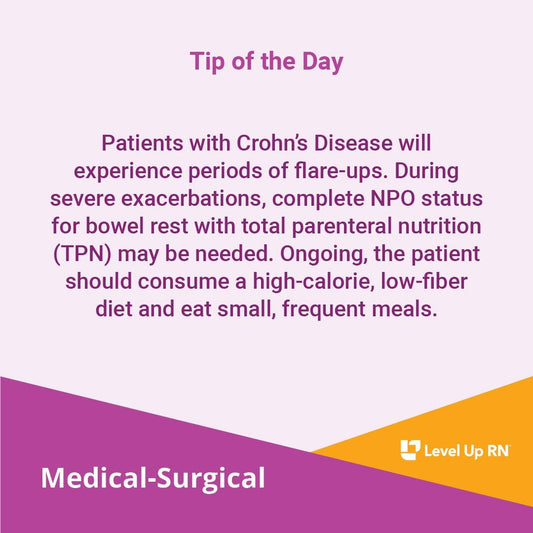
Crohn's Disease: Nursing Care
Patients with Crohn's Disease will experience periods of flare-ups. During severe exacerbations, complete NPO status for bowel rest with total parenteral nutrition (TPN) may be needed.
Crohn's Disease: Nursing Care
Patients with Crohn's Disease will experience periods of flare-ups. During severe exacerbations, complete NPO status for bowel rest with total parenteral nutrition (TPN) may be needed.

Hirschsprung Disease
If an infant has not passed meconium within the first 48 hours of life, they should be evaluated for Hirschsprung Disease. A colostomy may be needed in this case after...
Hirschsprung Disease
If an infant has not passed meconium within the first 48 hours of life, they should be evaluated for Hirschsprung Disease. A colostomy may be needed in this case after...
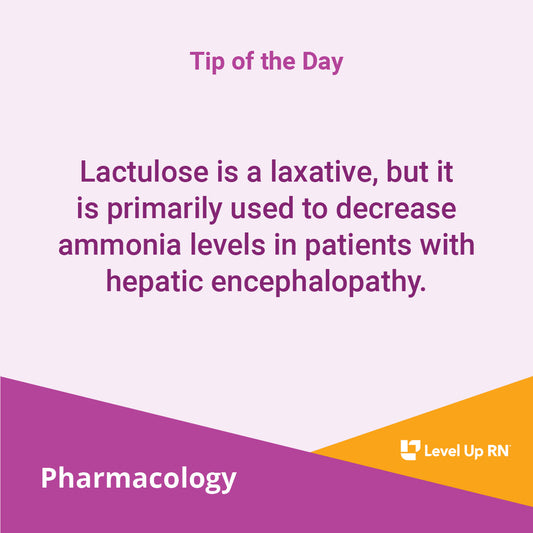
Primary use of Lactulose
Lactulose is a laxative, but it is primarily used to decrease AMMONIA levels in patients with hepatic encephalopathy.
Primary use of Lactulose
Lactulose is a laxative, but it is primarily used to decrease AMMONIA levels in patients with hepatic encephalopathy.
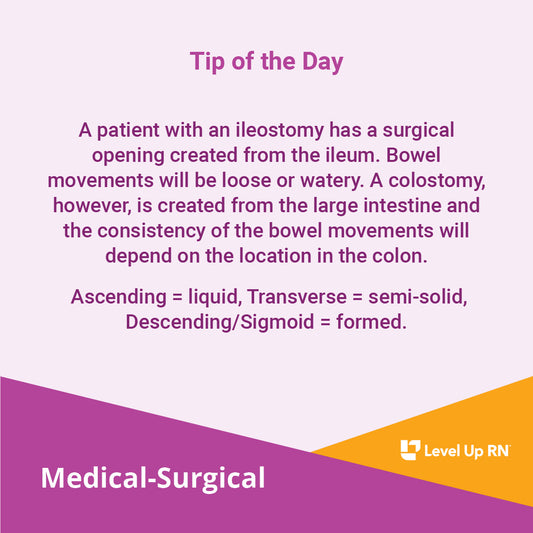
Ileostomoy versus Colostomy
A patient with an ileostomy has a surgical opening created from the ileum. Bowel movements will be loose or watery. A colostomy, however, is created from the large intestine and...
Ileostomoy versus Colostomy
A patient with an ileostomy has a surgical opening created from the ileum. Bowel movements will be loose or watery. A colostomy, however, is created from the large intestine and...

Proton Pump Inhibitors
Omeprazole and Pantoprazole are Proton Pump Inhibitors used to treat duodenal and gastric ulcers, GERD, and Zollinger-Ellison syndrome. HINT: I will take Omeprazole and pray my ulcer pain goes away....
Proton Pump Inhibitors
Omeprazole and Pantoprazole are Proton Pump Inhibitors used to treat duodenal and gastric ulcers, GERD, and Zollinger-Ellison syndrome. HINT: I will take Omeprazole and pray my ulcer pain goes away....

Proton Pump Inhibitors: Patient Teaching
Educate patients taking proton pump inhibitors (e.g., omeprazole, pantoprazole) to report watery diarrhea, as these medications can cause C. diff by decreasing stomach acid production.
Proton Pump Inhibitors: Patient Teaching
Educate patients taking proton pump inhibitors (e.g., omeprazole, pantoprazole) to report watery diarrhea, as these medications can cause C. diff by decreasing stomach acid production.

Failure to Thrive (FTT)
Failure to Thrive (FTT) is indicated by a child's weight being less than the fifth percentile. Assess for both organic causes and parental bonding/care of the child.
Failure to Thrive (FTT)
Failure to Thrive (FTT) is indicated by a child's weight being less than the fifth percentile. Assess for both organic causes and parental bonding/care of the child.

Appendicitis: Nursing Care
A patient with appendicitis is likely to have RLQ pain at McBurney's Point along with rebound tenderness, nausea/vomiting, and fever.
Appendicitis: Nursing Care
A patient with appendicitis is likely to have RLQ pain at McBurney's Point along with rebound tenderness, nausea/vomiting, and fever.

Appendicitis: Family Teaching
When caring for a child with appendicitis, report to the provider any sudden relief of pain. This may indicate that the appendix has perforated and requires emergency surgery!
Appendicitis: Family Teaching
When caring for a child with appendicitis, report to the provider any sudden relief of pain. This may indicate that the appendix has perforated and requires emergency surgery!

Paracentesis: Nursing Care
A patient undergoing a paracentesis (drainage of fluid from the peritoneal cavity using a needle) must empty their bladder prior to the procedure.
Paracentesis: Nursing Care
A patient undergoing a paracentesis (drainage of fluid from the peritoneal cavity using a needle) must empty their bladder prior to the procedure.

Ostomy Patient Teaching
Ostomy patient teaching: Cut opening in skin barrier ≤ 1/8" bigger than the measured stoma size to prevent skin damage from contact with ostomy output. Assess stoma regularly - should...
Ostomy Patient Teaching
Ostomy patient teaching: Cut opening in skin barrier ≤ 1/8" bigger than the measured stoma size to prevent skin damage from contact with ostomy output. Assess stoma regularly - should...
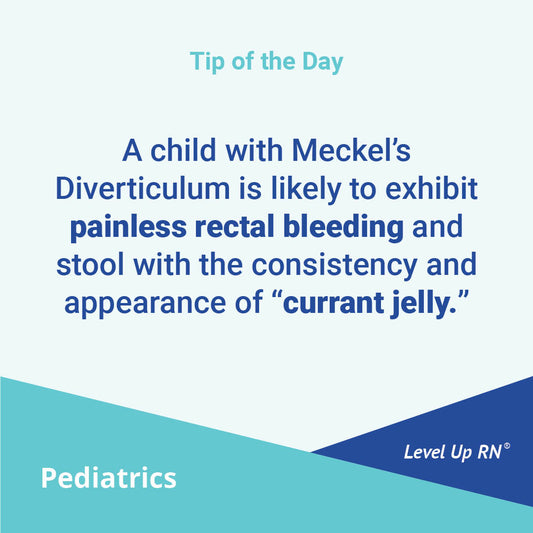
Meckel's Diverticulum
A child with Meckel's Diverticulum is likely to exhibit painless rectal bleeding and stool with the consistency and appearance of "currant jelly."
Meckel's Diverticulum
A child with Meckel's Diverticulum is likely to exhibit painless rectal bleeding and stool with the consistency and appearance of "currant jelly."

Peptic Ulcer Disease: Signs and Symptoms
A major complication of peptic ulcer disease is perforation of an ulcer. Assess for symptoms of perforation such as severe pain, fever, or a rigid/boardlike abdomen.
Peptic Ulcer Disease: Signs and Symptoms
A major complication of peptic ulcer disease is perforation of an ulcer. Assess for symptoms of perforation such as severe pain, fever, or a rigid/boardlike abdomen.
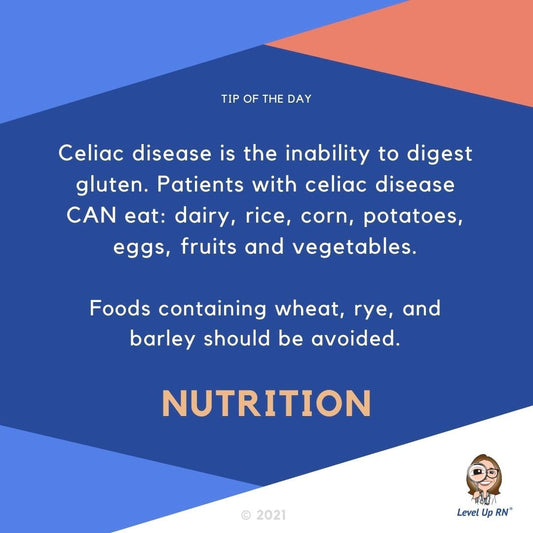
Celiac Disease
Celiac disease is the inability to digest gluten. Patients with celiac disease CAN eat: dairy, rice, corn, potatoes, eggs, fruits and vegetables. Foods containing wheat, rye, and barley should be...
Celiac Disease
Celiac disease is the inability to digest gluten. Patients with celiac disease CAN eat: dairy, rice, corn, potatoes, eggs, fruits and vegetables. Foods containing wheat, rye, and barley should be...

Severe Dehydration in Children
A child who is crying without producing tears should be evaluated for severe dehydration.
Severe Dehydration in Children
A child who is crying without producing tears should be evaluated for severe dehydration.

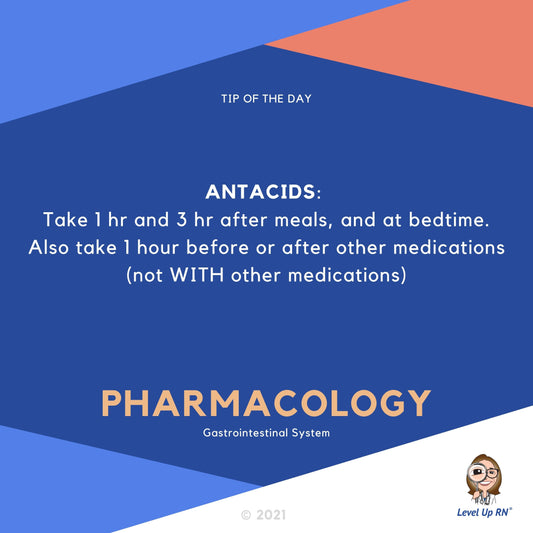
When to take Antacids
ANTACIDS: Take 1 hr and 3 hr after meals, and at bedtime. Also take 1 hour before or after other medications (not WITH other medications)
When to take Antacids
ANTACIDS: Take 1 hr and 3 hr after meals, and at bedtime. Also take 1 hour before or after other medications (not WITH other medications)
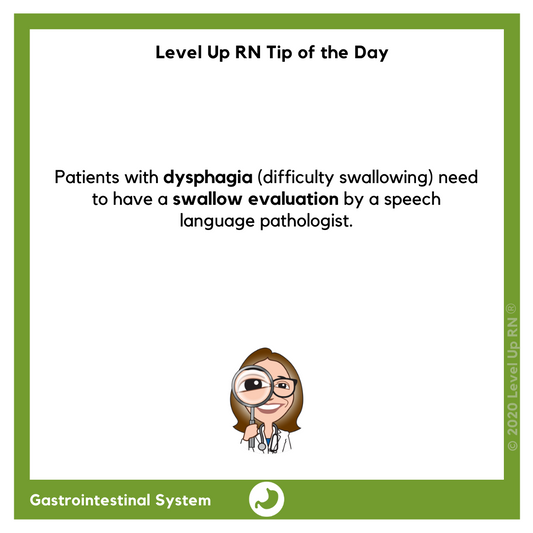
Dysphagia
Patients with dysphagia (difficulty swallowing) need to have a swallow evaluation by a speech language pathologist.
Dysphagia
Patients with dysphagia (difficulty swallowing) need to have a swallow evaluation by a speech language pathologist.

Gastric and Duodenal Ulcers
Key differences in symptoms for Gastric and Duodenal ulcers: Gastric ulcer: Pain 30-60 minutes after meal, worse in DAY, worse with eating. Duodenal ulcer: Pain 1.5-3 hours after meal, worse...
Gastric and Duodenal Ulcers
Key differences in symptoms for Gastric and Duodenal ulcers: Gastric ulcer: Pain 30-60 minutes after meal, worse in DAY, worse with eating. Duodenal ulcer: Pain 1.5-3 hours after meal, worse...
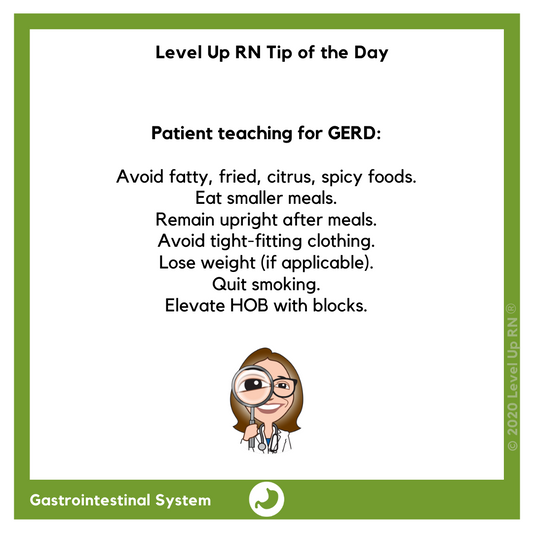
Patient Teaching for GERD
Patient teaching for GERD: Avoid fatty, fried, citrus, spicy foods. Eat smaller meals. Remain upright after meals. Avoid tight-fitting clothing. Lose weight (if applicable). Quit smoking. Elevate HOB with blocks.
Patient Teaching for GERD
Patient teaching for GERD: Avoid fatty, fried, citrus, spicy foods. Eat smaller meals. Remain upright after meals. Avoid tight-fitting clothing. Lose weight (if applicable). Quit smoking. Elevate HOB with blocks.
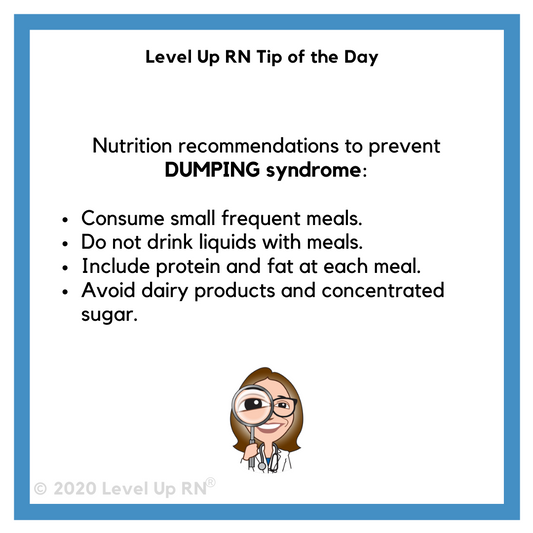
Dumping Syndrome Nutrition
Nutrition recommendations to prevent DUMPING syndrome: Consume small frequent meals. Do not drink liquids with meals. Include protein and fat at each meal. Avoid dairy products and concentrated sugar.
Dumping Syndrome Nutrition
Nutrition recommendations to prevent DUMPING syndrome: Consume small frequent meals. Do not drink liquids with meals. Include protein and fat at each meal. Avoid dairy products and concentrated sugar.
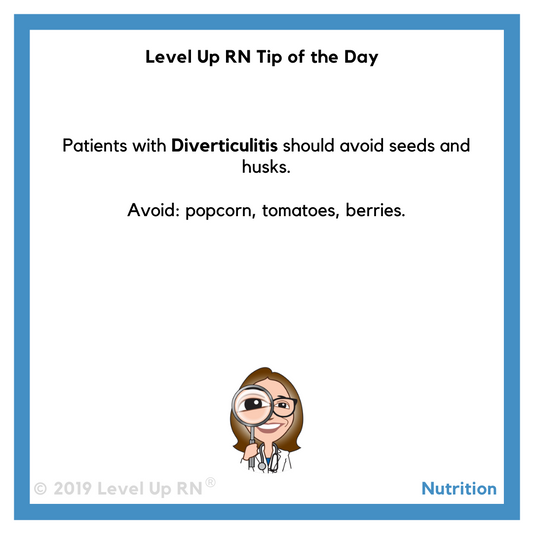
Diverticulitis Nutrition
Patients with Diverticulitis should avoid seeds and husks. Avoid: popcorn, tomatoes, berries.
Diverticulitis Nutrition
Patients with Diverticulitis should avoid seeds and husks. Avoid: popcorn, tomatoes, berries.
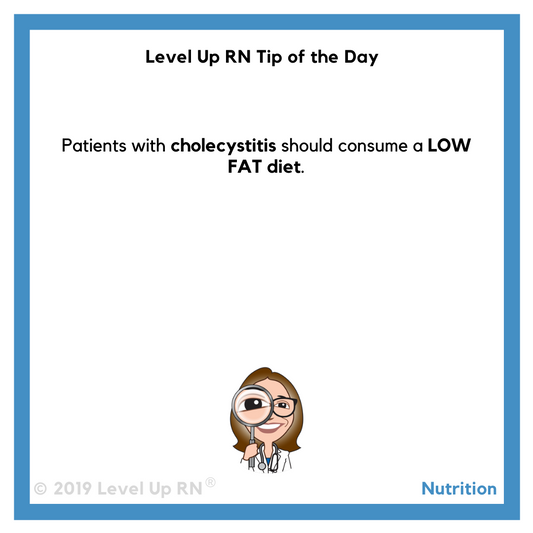
Cholecystitis Nutrition
Patients with cholecystitis should consume a LOW FAT diet.
Cholecystitis Nutrition
Patients with cholecystitis should consume a LOW FAT diet.
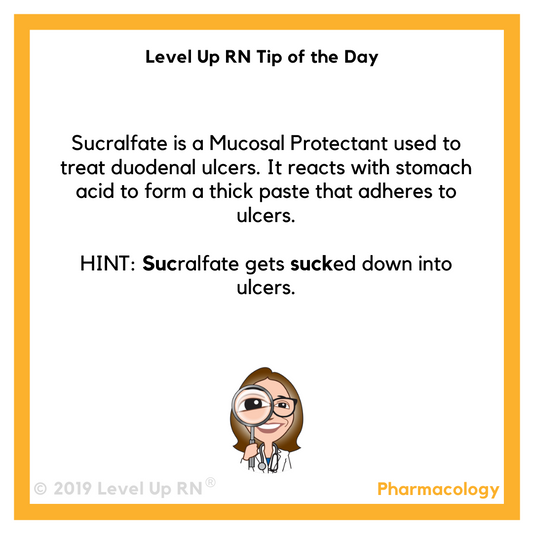
Sucralfate
Sucralfate is a Mucosal Protectant used to treat duodenal ulcers. It reacts with stomach acid to form a thick paste that adheres to ulcers. HINT: Sucralfate gets sucked down into ulcers.
Sucralfate
Sucralfate is a Mucosal Protectant used to treat duodenal ulcers. It reacts with stomach acid to form a thick paste that adheres to ulcers. HINT: Sucralfate gets sucked down into ulcers.

IBS Medications
Irritable Bowel Syndrome (IBS) Medications: alosetron is used for IBS w/diarrhea.HINT: You might aloe on your backside from all that diarrhea. Lubiprostone is used for IBS w/consipation. HINT: Use lubiprostone to "lube up...
IBS Medications
Irritable Bowel Syndrome (IBS) Medications: alosetron is used for IBS w/diarrhea.HINT: You might aloe on your backside from all that diarrhea. Lubiprostone is used for IBS w/consipation. HINT: Use lubiprostone to "lube up...

Ondansetron
Ondansetron is an antiemetic (used to prevent nausea and vomiting). Hint: "I threw up on DAN. Better get me some ondansetron."
Ondansetron
Ondansetron is an antiemetic (used to prevent nausea and vomiting). Hint: "I threw up on DAN. Better get me some ondansetron."
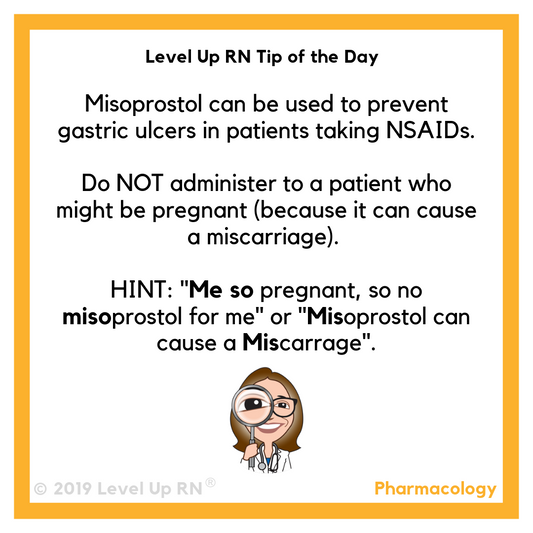
Misoprostol and Pregnancy
Misoprostol can be used to prevent gastric ulcers in patients taking NSAIDs. Do NOT administer to a patient who might be pregnant (because it can cause a miscarriage). HINT: "Me...
Misoprostol and Pregnancy
Misoprostol can be used to prevent gastric ulcers in patients taking NSAIDs. Do NOT administer to a patient who might be pregnant (because it can cause a miscarriage). HINT: "Me...

Histamine 2 Receptor Antagonists and DINE-ing
Histamine 2 receptor antagonists (ex: ranitidine and famotidine) are used to treat ulcers and GERD. These meds will help you feel better when you "dine".
Histamine 2 Receptor Antagonists and DINE-ing
Histamine 2 receptor antagonists (ex: ranitidine and famotidine) are used to treat ulcers and GERD. These meds will help you feel better when you "dine".

Administering misoprostol
When administering a misoprostol (for prevention of gastric ulcers) to a person of child-bearing age, be sure to run a PREGNANCY test first as this medication can cause a miscarriage!
Administering misoprostol
When administering a misoprostol (for prevention of gastric ulcers) to a person of child-bearing age, be sure to run a PREGNANCY test first as this medication can cause a miscarriage!

Choking hazard foods
The following foods pose a choking hazard for small children: popcorn, raisins, peanuts, grapes, raw carrots, hotdogs, celery, peanut butter, candy, tough meat.
Choking hazard foods
The following foods pose a choking hazard for small children: popcorn, raisins, peanuts, grapes, raw carrots, hotdogs, celery, peanut butter, candy, tough meat.

Albumin and prealbumin
When evaluating a patient's nutritional status, be sure to check: albumin (normal range: 3.5-5) and prealbumin levels (normal range 15-36).
Albumin and prealbumin
When evaluating a patient's nutritional status, be sure to check: albumin (normal range: 3.5-5) and prealbumin levels (normal range 15-36).
Filter Articles
Shop
The Ultimate Nursing School Survival Kit - with Flashables and Membership
4.875 / 5.0
(240) 240 total reviews
Regular price $349.95Regular priceUnit price / per$817.95Sale price $349.95SaleVideos by Subject
Tips & More
Exam Information
Subscribe


